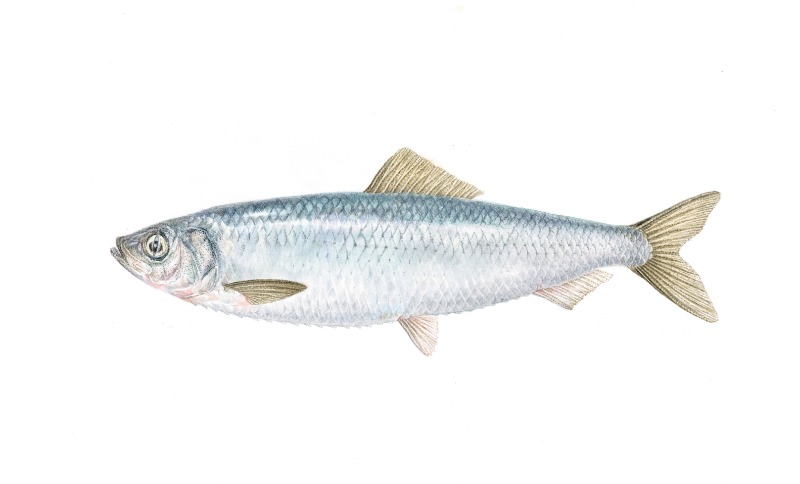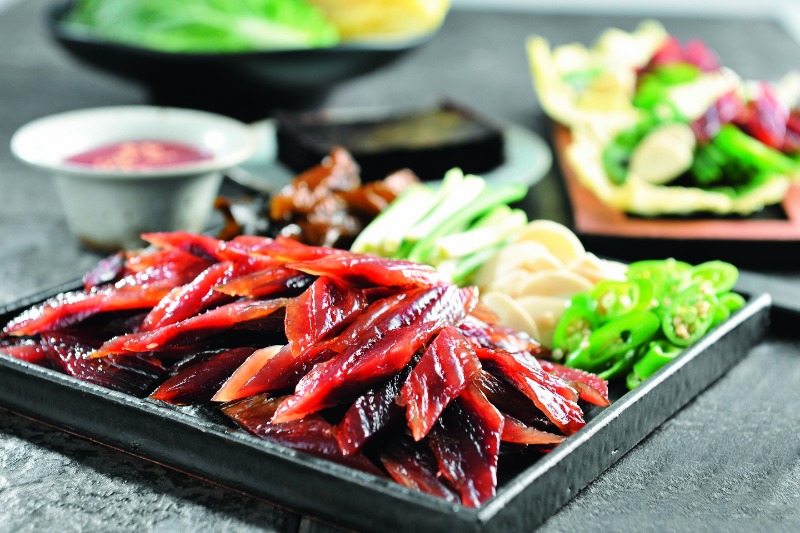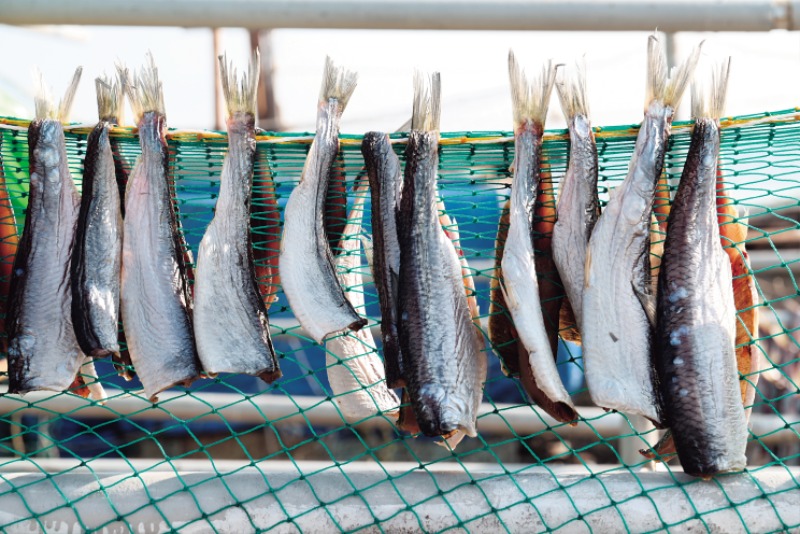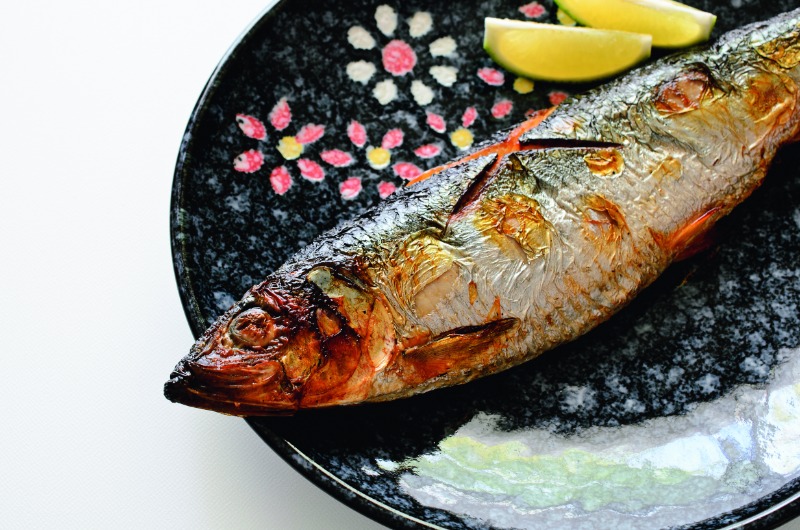Herring has long been a staple food around the world. In Korea, gwamegi, herring dried in the sea breeze, is eaten wrapped with seaweed, dried laver, garlic and vegetables. This is a common dish, but various other traditional recipes have also been passed down.

Herring is familiar to people all over the world. The thin, blueback fish, silvery white from center to belly, live in schools in cold coastal currents with a temperature of 2-10 degrees Celsius and a water depth of less than 150 meters. Herring yields in Korean waters are very irregular, but the catch this winter is known to be good.
“The most eaten is pollack; the best eaten is herring.” This old saying means that among the three typical fish on the Korean table – cod, pollack and herring – herring is the tastiest.
Herrings are called cheongeo in Korean, which literally means “blue fish.” Diverse herring species roam the seas in large schools. The North Atlantic herring (Clupea harengus) is the most popular in Northern Europe, while the Pacific herring (Clupea pallasii) is caught off the coasts of Northeast Asia and North America.
White fish, such as cod or pollack, are low in fat, but herring has a fat content as high as 20 percent. As a cold-water fish, it spawns from winter to spring and gets fat in late autumn. In addition, it’s rich in free amino acids, such as glycine and alanine, that make its flesh taste sweet.
Korea’s earliest known atlas of fish, “Register of Rare Fish in the Jinhae Sea” (Uhae ieobo), written in 1803 by Kim Ryeo (1766-1821), says the taste of herring is “sweet and soft, and very delicious when grilled.” Chef and writer Park Chan-il describes the taste in a similar way. In his 2012 book, “Half of the Memories Are Taste,” he recalls the grilled herring that he ate with a friend at the Sokcho seaside along the east coast: “On a windy winter day, the herring sprinkled with coarse salt and grilled over charcoal was soft and sweet.”
RECIPES
Herrings are eaten in many ways. On the east coast, where most herrings are caught in Korea, they are eaten raw, dipped in sauce or mixed with various ingredients. Sometimes they are boiled to make a broth for rice porridge, or covered in flour and egg batter, pan-fried and then braised in a soy sauce-based soup. In the Gyeongsang region, along the southeast coast, they are also cooked in a kind of stew. One record says that in the Jeolla region in the southwest, large quantities of herrings were steamed in a cauldron over boiling water and eaten dipped in red pepper paste. However, herrings taste best when grilled. Sprinkled with coarse salt and grilled until golden, their soft meat is sweet and savory. Chef Park explains, “Herrings are very oily, so when grilled they cook in their own oil, turning amazingly delicious.”
Saltwater fish contain trimethylamine oxide (TMAO), a non-protein nitrogen compound that helps maintain the balance between seawater and body salinity. When this compound is decomposed into trimethylamine (TMA) by microorganisms, it gives off a fishy smell. Herrings, full of oil in winter, contain a lot of polyhydric fatty acids, which means they go rancid easily. It also means their fishy smell is stronger, but this can be alleviated by adding doenjang (soybean paste) to herring stew or applying some on the fish before grilling it. Not only do the fragrant substances in doenjang cover the fishy smell, its proteins bind to the substance that causes the smell and prevent it from volatizing.
Since the 1990s, however, herring recipes ha-ven’t been diverse. On January 27, 1996, the daily Dong-A Ilbo carried an article saying, “These days, it’s hard to see Gyeonggi regional style dishes such as herring stew, herring boiled down in soy sauce, salted herring and herring porridge.”
The fish tend to come and go, which is a major culprit for this lack of variety; yields have always been inconsistent. Swimming in large schools following cold currents, they have at times been caught in hauls among the largest of any fish. Then they would sometimes disappear, for up to almost 10 years at a time. “A Record of Penitence and Warning” ( Jingbirok) by Ry u Seong-ryong (1542-1607), an account of the Japanese invasions in the late 16th century, describes a strange event just before the outbreak of war: “Fish from the East Sea were caught in the West Sea and gradually reached the Han River; the herrings, originally from Haeju, had not been found there for more than 10 years because they had moved to the Liaohai Sea off the Liaodong Peninsula, where they were called xinyu[meaning “new fish”].”
A similar explanation is found in the encyclopedic book, “Topical Discourses of Jibong” (Jibong yuseol), written in 1614 by Yi Su-gwang (1563-1629). It says that herrings, which had always been plentiful in the southwestern sea in spring, were not seen there for over 40 years. But “War Diary” (Nanjung ilgi) by Admiral Yi Sun-sin (1545-1598) states that herrings were caught and exchanged for provisions to feed his soldiers.
Scholar Yi Ik (1681-1764) quoted Ryu Seongryong in his book, “Miscellaneous Explanations of Seongho” (Seongho saseol), in explaining the situation. At the time that Ryu wrote his book, herrings, which had previously been found only in the sea off Haeju, in Hwanghae Province, could now be caught in all Joseon waters. He wrote that herrings were “caught in Hamgyong Province [in the northeast] every fall” and “gradually moved to Jeolla and Chungcheong provinces [in the southwest and west] in spring. They were caught in Hwanghae Province [further northward in the west] between spring and summer, but as they gradually moved west, they grew smaller and more common, so there was no one who couldn’t eat them.”
Yi Ik assumed that the huge change in herring catches and locations was due to the way the fish followed the changing climate and environment. Although this speculation was made 250 years ago, it was spot on. An analysis of herring catchesin the seas around the Korean Peninsula between 1970 and 2019 by the National Institute of Fisheres Science says that catches increased in the East Sea as the water temperature increased, whereas they fell in the West Sea as the water temperature rose. It’s because the East Sea has cooler water than the West Sea.
According to this study, herring catches have been very unstable over the past 50 years. The annual haul approached 5,000 tons until the early 1970s before falling below 1,000 tons in the mid-1970s. The figure began to rebound in the late 1980s, peaking at 20,000 tons in 1999, but plummeted to below 2,000 tons in 2002. In the mid-2000s, catches surged again, reaching a whopping 45,000 tons in 2008. The herring boom continued the following year, and on December 20, 2009, KBS reported on its primetime news broadcast that the missing herring had returned. According to the report, herring, a cold current fish, was being caught not only in the East Sea but also in the warm southeast and southern seas, and as a result, gwamegiproduction resumed in Yeongdeok, North Gyeongsang Province.

Herring is familiar to people all over the world. The thin, blueback fish, silvery white from center to belly, live in schools in cold coastal currents with a temperature of 2-10 degrees Celsius and a water depth of less than 150 meters. Herring yields in Korean waters are very irregular, but the catch this winter is known to be good.

In Yeongdeok, North Gyeongsang Province, and other coastal villages along the East Sea, winter is the busy herring drying season. With the heads cut off, the fish are repeatedly frozen and thawed in the cold sea breezes. The result is savory gwamegi without a strong fishy smell.
© Jeon Jae-ho
DRYING
Though gwamegi originally refers to dried herring, due to falling catches of the fish since the 1960s, it was mainly made from saury (kkongchi) in the coastal regions of North Gyeongsang Province. In a column in the Dong-A Ilbo on May 9, 1939, the ichthyologist Jeong Mun-gi (1898-1995) wrote, “In North Gyeongsang Province, which is a prolific herring region, dried herrings are called ‘gwamigi,’ which is an important local specialty.”
These days, gwamegi is often eaten wrapped in vegetables such as cabbage or sea plants such as laver, seaweed and sea tangle, whereas in the past, it was grilled or cooked in soup with mugwort.
Where the word gwamegi comes from isn’t clear. In his book “Record of Hunting and Fishing” (Jeoneo ji), the late Joseon scholar Seo Yu-gu (1764-1845) wrote that whole herrings were tied together with straw rope and hung in the sun to dry. That is, they were dried whole rather than cut open at the back. Seo claimed that herrings have transparent eyes that can be pierced with rope to tie them up, which is why they are called gwanmok, meaning “piercing eyes.” Some say that this word evolved to become gwamegi.
Although drying whole herrings isn’t the most common method, it has continued to this day. Usually, the fish are cut in half, their intestines and bones removed, before drying in the sea breeze for a short period of time. Drying whole herrings takes a long time – longer than saury – as herrings are wide-bodied and oilier. If a whole saury can be dried in a half month, a whole herring takes at least a month. However, the longer the drying period the deeper the taste. Herrings dried whole in the middle of winter also have eggs, which make them even more flavorful.
The herring is back; this year’s catch is plentiful. In Samcheok, Gangwon Province, on the east coast, various ways of processing the fish – making fish cakes, stewing and deep frying – are being developed to promote consumption. The National Institute of Fisheries Science explains that rising yields since the 2000s are due mainly to higher water temperatures in the East Sea.
Herrings taste best when grilled.
Sprinkled with coarse salt and grilled until golden, their soft meat is sweet and savory.

When grilled, the oily herring is soft and melts in your mouth, its flavor amplified. On the downside, the fish contains a lot of fine bones, which makes it rather fiddly to eat. Scale the washed herring, make a few cuts on it and sprinkle with salt. Grill the fish until the meat turns yellowish and has a sweet and savory flavor.
© Shutterstock
CATCHES
However, researchers caution against unrestrained fishing. Given the precedent of plummeting catches resulting from overfishing in the North Atlantic, experts say that catching young herring should be banned. Notably, overfishing in Norway in the 1970s caused herring catches to nosedive to less than one ton, with numbers taking 20 years to recover previous levels.
There is still a lot we don’t know about how herrings migrate in schools. Although they have returned to the East Sea, they remain difficult to catch in the other waters in Northeast Asia, such as the West Sea [Yellow Sea] and the sea off Hokkaido, Japan. The reasons have yet to be found. Rather than recklessly catching, we must therefore be humble in the way we treat these fish – and nature as a whole.